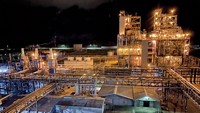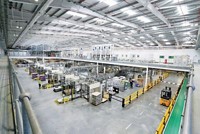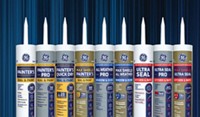Advertisement
Grab your lab coat. Let's get started
Welcome!
Welcome!
Create an account below to get 6 C&EN articles per month, receive newsletters and more - all free.
It seems this is your first time logging in online. Please enter the following information to continue.
As an ACS member you automatically get access to this site. All we need is few more details to create your reading experience.
Not you? Sign in with a different account.
Not you? Sign in with a different account.
ERROR 1
ERROR 1
ERROR 2
ERROR 2
ERROR 2
ERROR 2
ERROR 2
Password and Confirm password must match.
If you have an ACS member number, please enter it here so we can link this account to your membership. (optional)
ERROR 2
ACS values your privacy. By submitting your information, you are gaining access to C&EN and subscribing to our weekly newsletter. We use the information you provide to make your reading experience better, and we will never sell your data to third party members.
Materials
Vanishing Plants
Latest closures are ending chemical production at the only U.S. facilities of their kind
by Michael McCoy
September 21, 2009
| A version of this story appeared in
Volume 87, Issue 38

DuPont’s Hypalon business had one of its best years ever in 2006. The chlorosulfonated polyethylene (CSPE) elastomer was enjoying renewed sales growth, and customer interest was high. In response to the upturn, DuPont restarted a development facility at its Beaumont, Texas, site and staffed it with several experienced chemists.
Fast-forward to May 2009. Early that month, DuPont sent a letter to customers informing them that it would close the Hypalon plant. “This step is necessary in view of the significant deterioration of sales volume in all major regions and end-use market segments and our assessment that this business has ceased to be sustainable over the long term,” the firm said.
Plants close in hard times, and the DuPont shutdown can be seen as just another corporate response to the global economic slump. But like several other chemical plants that shut down recently or are in the process of being closed, the Hypalon facility was unique in an important way: It was the only U.S. plant of its kind.
Any plant closure hurts the chemists, engineers, and production workers that kept the facility running. The shutdown of a plant that was the sole source of a chemical, though, leaves the country without production of a raw material that might be critical to numerous manufacturing companies. Because of the way chemicals are woven into the nation’s industrial fabric, the closure of these plants is another blow to customers who are already struggling with the recession and the rise of global competitors.
“You are stretching your supply chain,” says Edward Pruitt, chief procurement officer at Sun Chemical, a large buyer of solvents, polymers, and other chemicals for the production of inks and coatings. “It is painful, and it exposes not only the customer to risk and additional costs but also the customer’s customer to risks and additional costs.”
The disappearance of these plants is one way in which this recession is different from recessions that have come before it. In addition to the Hypalon plant, Dow Chemical facilities making solution vinyl resins and chlorinated polyethylene, a Celanese plant producing formic acid, and a Nova Chemicals plant making a styrene maleic anhydride copolymer are shutting down and leaving the U.S. without local production.
Ironically, the closures are occurring as the Obama Administration and industrial leaders are calling for a revival of U.S. manufacturing. The U.S. government is investing billions of dollars to create a domestic infrastructure for batteries and other electric-vehicle components. And President Obama is said to be preparing to name a manufacturing “czar” who will help craft U.S. industrial policy.
In a speech at the Detroit Economic Club earlier this year, General Electric Chief Executive Officer Jeffrey R. Immelt lamented the country’s outsized reliance on the service sector. “Many bought into the idea that America could go from a technology-based, export-oriented powerhouse to a services-led, consumption-based economy and still expect to prosper. That idea is just flat wrong,” he said.
Immelt was in Detroit to announce the construction of a $100 million manufacturing and software development center that GE says will employ 1,100 scientists, engineers, and technology experts. In the talk, he said that the U.S. should set a national goal to make manufacturing jobs account for as much as 20% of total employment, about twice what they are today. “You know something is wrong when a mortgage broker is pulling down $5 million per year and a Ph.D. chemist is earning $100,000,” Immelt said.
Although the chemical plant shutdowns are eliminating hundreds of manufacturing and related jobs, most U.S. customers will continue to be served—but by offshore producers that are stepping in to fill the void. A question still unanswered is whether these customers can remain competitive with imported raw materials.

A straightforward case is the closure of Celanese’s Pampa, Texas, complex early this year, a move that ended U.S. production of formic acid, which is a versatile chemical used in everything from silage to drilling fluids. BASF, the world’s largest producer of formic acid, was a major buyer of Celanese’s product for sale to its North American customers.
The German firm responded by setting up the necessary infrastructure and increasing imports from Ludwigshafen, Germany, and Nanjing, China, where it operates 255,000 tons per year of total capacity. Teressa Szelest, vice president of BASF’s intermediates business in North America, said last December that the new supply chain ensures BASF’s U.S. customers will have a reliable supply.
Other times, as in the case of Tyrin, Dow’s brand of chlorinated polyethylene (CPE), the supply gap gets filled from more than one direction.
Late last year, as the country was heading deeper into recession and Dow was struggling to complete its acquisition of Rohm and Haas, the company started closing multiple chemical facilities in the U.S. and elsewhere. On Dec. 5, 2008, it announced the closure of a chlorine plant in Texas; styrene and styrene derivative plants in Texas, California, the Netherlands, and Canada; and elastomer facilities in Texas and Louisiana. The Louisiana plant, in the Gulf Coast town of Plaquemine, made Tyrin, and by April 2009 it was closed.
Other firms saw an opportunity to move in. Jamil A. Khan, vice president of sales and marketing at Lianda, an Ohio-based importer of rubber and plastics, says his firm is starting to supply former customers of Dow’s Plaquemine plant with CPE produced by the Chinese firm Yaxing Chemical. CPE is used in a wide variety of applications, including wire and cable jacketing, automotive hoses, molded shapes, geomembranes, and as an impact modifier for other polymers.
Lianda estimates that Dow had about 45,000 tons of CPE capacity in Plaquemine with which it supplied almost 80% of the U.S. market last year. That would imply that the shutdown has hit most U.S. CPE users. But Lianda says Yaxing has 170,000 tons of CPE capacity—more than enough to supply the U.S. Furthermore, Khan says that the company plans to add another 20,000 tons of capacity by next year.
To ensure a supply buffer, Yaxing keeps an inventory in China that will last at least 30 days, Khan says. Plus, Lianda operates six warehouses across the U.S. “It’s just like a plant next door supplying you,” he says.
Dow continues to make CPE at a smaller plant in Stade, Germany. Peter Heydasch, product manager for Tyrin, argues that geography is not that important and that Dow can supply the globe from the German plant. However, Khan is skeptical that Tyrin can be imported from Germany at a competitive price. “We have already captured significant additional business in North America,” he says.
For buyers of DuPont’s Hypalon, however, the transition from a domestic to an overseas supplier has been rockier. DuPont is by far the world’s largest manufacturer of CSPE, commanding 87% of global capacity last year, according to a report on the product published in April by SRI Consulting. Emanuel V. Ormonde, an SRI consultant, says the only other producers are PetroChina and Japan’s Tosoh. Likewise, the U.S. consumed about two-thirds of the world’s CSPE output, Ormonde says.
The SRI report says CSPE elastomers have been adopted by “a vast assortment of industries.” Uses include roofing membranes, pond liners, auto hoses and belts, printing rolls, wire and cable, and coatings.
One particularly specialized application is the rubber gloves used to manipulate objects inside glove boxes, the containment compartments many labs use to isolate hazardous or highly pure materials. Lynn Aurelius, sales manager for the Americas and the Pacific Rim at Piercan USA, a high-tech glove maker in San Marcos, Calif., says she was “absolutely shocked” when she heard of the impending DuPont shutdown.
Piercan is one of two main suppliers of the gloves, which are primarily purchased by the nuclear and pharmaceutical industries for working with radioactive materials and highly potent drug compounds. “We are a very small niche market, but it’s a critical market,” Aurelius says.
After learning about the shutdown, Aurelius and other Hypalon users began barraging DuPont and its distributors with phone calls to try to understand what was happening. Two months later, a DuPont marketing manager participated in a conference call with members of the American Glovebox Society. DuPont declined to speak to C&EN about the closure, but according to the minutes from the call, the manager explained that the company experienced a sudden reduction in Hypalon sales in October 2008.
The plant, with a production capacity of 90,000 tons per year, already had environmental, maintenance, and safety issues, the manager said, in part stemming from its use of carbon tetrachloride as a process solvent. When Hypalon demand plummeted, the company made the decision to shut it down.
The manager acknowledged to the glove-box society members that DuPont didn’t fully understand Hypalon’s importance to their industry. The company originally planned to close the facility on June 30, but following customer protests it agreed to run the plant long enough this year to fill all advanced orders. The facility has about 80 employees.
There’s a lot at stake for Piercan. It just invested $2.5 million to upgrade its San Marcos plant to make next-generation gloves based on a blend of polyurethane and Hypalon.
The firm is seizing on DuPont’s production extension and purchasing enough Hypalon to last for two years, Aurelius says. “But in two years, what’s going to happen?” she asks. Gloves made with Hypalon or the Hypalon-polyurethane blend are much preferred by the nuclear and pharmaceutical industries, she says. Alternative materials such as butyl rubber and neoprene are considered inferior.
Piercan has started testing CSPE manufactured by the two overseas suppliers. Initial results are promising, but Aurelius is concerned about the Asian companies’ ability to supply the global market. Although both firms have indicated they are considering plant expansions, neither has committed to going ahead. And even if they do, she says, it will take the nuclear industry up to 18 months to revalidate gloves made with CSPE from another source.
Managers in other industries are largely downplaying the potential impact of the DuPont shutdown. In the roofing field, which uses Hypalon to build long-lasting and energy-efficient roofs for commercial facilities, companies are placing their bets on overseas CSPE producers.
Stephen Roades, vice president of Burke Industries’ roofing and environmental products division, says he is disappointed that DuPont has opted to exit the Hypalon business. Nonetheless, he says, Burke is confident the second-source suppliers will be able to fulfill the firm’s needs.
Given the other producers’ small slice of global capacity, however, SRI Consulting’s Ormonde figures that CSPE buyers are in for a tough time. “It has a domino effect,” he says of the DuPont shutdown. “End users who need these products could suffer.”
Indeed, in the wire and cable industry, companies are starting to launch products made with alternative elastomers. Champlain Cable, for example, has come out with a line of cables called Exar XLE that it is positioning to replace Hypalon-covered cable. Made with a jacket of cross-linked polyethylene and other elastomers, the cables can be used in applications such as motor lead wires and electronic control panels.
Rick Antic, the firm’s vice president of business development, says three or four customers have switched from Hypalon-based cable to Exar XLE. Still, he doesn’t detect a sense of urgency in the wire and cable market. “I don’t think there is the perception of a problem in the industry, even though we think there is,” he says.
Customers of another doomed chemical plant—Dow’s solution vinyl resins (SVR) facility—will likely get by, but not without difficulties. The Texas City, Texas, facility is one of only a handful of its kind in the world. Although it employs a proprietary polymerization process that yields unique products, Dow says the business is still in decline.
“In recent years, we have experienced ever-weakening demand for SVR products,” Hideyuki Ohnishi, a Dow business director, said when the closure was announced. “As demand has fallen, costs have escalated and pushed our margins to unacceptable levels. With these conditions, and with the age and disadvantaged cost position of the one asset we have for the manufacture of these products, the business is no longer sustainable.”
Advertisement
Dow said it would continue operating the plant into the second half of 2009 so customers have an opportunity to meet “last-time volume requirements.” The company declined to discuss its plans to help customers transition to other suppliers, although it did say recently that the plant is still running.
Pruitt, Sun Chemical’s procurement chief, says his company has identified alternative suppliers—two in Europe and one each in Japan, China, and Brazil—and is working to qualify them. “But it takes time,” he says. The transition involves people and resources at quality-control laboratories, at Sun plants, and at the plants of Sun’s customers.
Pruitt is of two minds about a shutdown like the one Dow will be undertaking in Texas City. As a businessman, he understands the economic and financial realities that Dow faces. “I realize that there are fundamental business decisions that people have to make,” he says.
At the same time, he’s not happy about the effort his company now must undertake because of that decision. “Once upon a time, Dow came knocking on the door with these hot products it thought would have great applications in this industry,” he says. Sun and its customers invested time and effort to adopt them. “So when we are told that they don’t fit a strategic direction anymore, it is frustrating,” he adds.
And although Pruitt says Sun is making progress in its search for alternative SVR suppliers for its ink products, companies that require the polymer to make coatings for steel cans and other food containers could have a harder time of it.
Stephen Fitzpatrick, technical director for World Wide Partnership, the distributor of SVR manufactured by Brazil’s Braskem, has been in the vinyl industry for 35 years. He says companies that use SVR in food-contact applications need a full year to win the regulatory approvals necessary to switch raw material suppliers. “Many of those people are really in trouble,” he warns.
Furthermore, Fitzpatrick figures that Dow’s Texas City plant represents between 30 and 50% of global SVR production capacity. By his calculation, the remaining manufacturers don’t have the excess capacity to supply the market once Dow completes its shutdown.
SVR demand is on the decline in the U.S., Fitzpatrick acknowledges, but he says it can still be a profitable business. In his view, plant shutdowns such as Dow’s have less to do with profitability than with the prevailing culture in U.S. business. “U.S. managers look at a declining market as something they don’t want to be involved with,” he says. “They tend to turn tail and run.”
Lianda’s Khan argues that the U.S. has already abdicated its manufacturing role in many businesses and that a product like SVR is better supplied from China. “Go to Walmart; 99% of the products are made in China,” he says. Khan understands the concern over the decline of U.S. manufacturing, but he maintains that consumers have benefitted from production in lower cost locations.
“When it comes to the bottom line—their pockets—they do see the advantage that has come from the shift of manufacturing to outside the U.S.,” Khan says.
Sun’s Pruitt has heard all of these arguments before. These days, the intermediates Sun requires for pigment manufacture are almost entirely made in China and India. “We’ve learned to successfully deal with that,” he says. Still, he can’t help but be a little disturbed when a plant shutdown like Dow’s is announced.
“The U.S. has been such a powerhouse in the chemical and polymer sciences and in capitalizing on the unique advantage it has in terms of natural resources,” Pruitt says. “I struggle to accept the idea that it’s an eroding or depleting industry.”





Join the conversation
Contact the reporter
Submit a Letter to the Editor for publication
Engage with us on Twitter